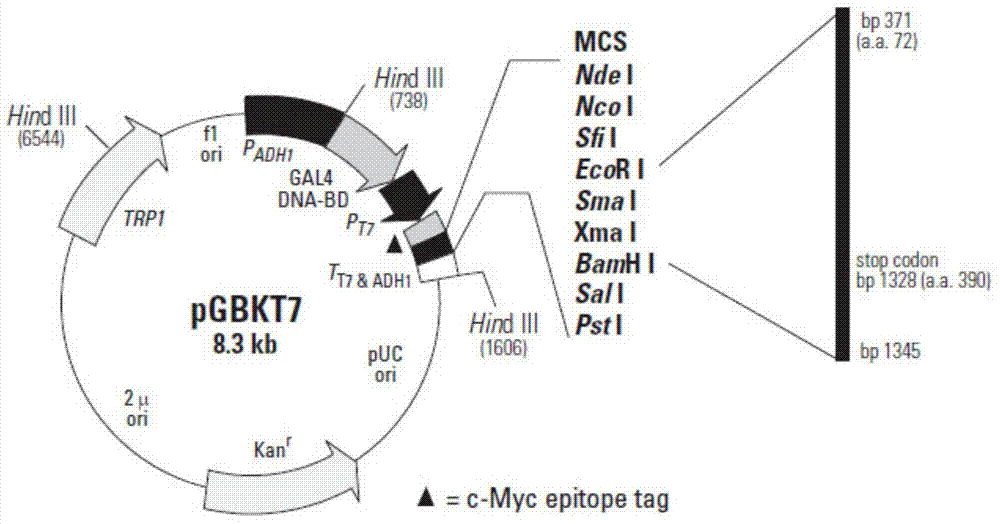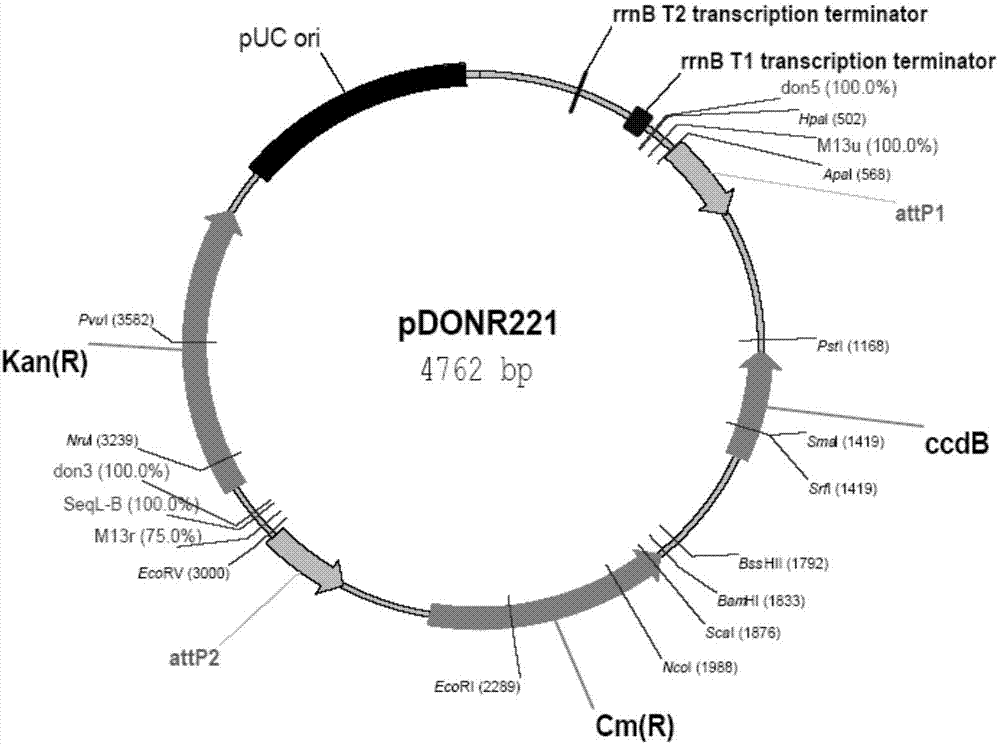Soybean salt-tolerant gene GmCIPK2 and application thereof
A salt-tolerant gene, soybean technology, applied in application, genetic engineering, plant genetic improvement and other directions to achieve the effect of improving salt tolerance
- Summary
- Abstract
- Description
- Claims
- Application Information
AI Technical Summary
Problems solved by technology
Method used
Image
Examples
Embodiment 1
[0018] Example 1: Yeast cDNA library construction of soybean 371005
[0019] Collection of salt-tolerant soybean germplasm: the inventor of the present invention collected and screened out a kind of salt-tolerant, low-temperature sensitive soybean germplasm (soil salt concentration (‰) in Qijia Village, Mingji Township, Lijin County, Dongying City in October 2009 ): 1.5, latitude / °: 37.59, longitude / °: 118.22, altitude / m: 10). According to the number starting with 37 in Shandong Province, the 1005th resource was named 371005 (Collection Number of Germplasm Resources in Coastal Areas of Shandong Province); its relative salt damage index: 18.00.
[0020] 1.1 Extraction of total RNA from soybean 371005 plants:
[0021] (1) Put the soybean 371005 material into a pre-cooled mortar, add liquid nitrogen and quickly grind it into a uniform powder;
[0022] (2) After the liquid nitrogen volatilizes, quickly transfer the material into a pre-cooled centrifuge tube, add 1ml TRIZOL solut...
Embodiment 2
[0135] Embodiment 2, Arabidopsis flower transformation of Agrobacterium-mediated GmCIPK2
[0136] 2.1 Overexpression vector construction
[0137] (1) Using the Gateway system of Invitrogen Company, the GmCIPK2 gene was connected to the pDONR221 vector by BP reaction (see image 3 ), the following primers SEQ ID No.9-10 are added to GmCIPK2 by the PCR reaction of high-fidelity DNA polymerase;
[0138] P3 (upstream primer): 5'-AAAAAAGCAGGCTTCATGGAGTACCCATACGACGT-3' (SEQ ID No.9)
[0139] P4 (downstream primer): 5'-AGAAAGCTGGGTCGGTACGTCGTATGGGTACTCCAT-3' (SEQ ID No.10);
[0140] (2) Take 25 μl of PCR product, use TE Buffer (10mM Tris-HCl pH 7.5, 1mM EDTA), 1 / 2 volume of 30% PEG 8000 / 30mM MgCl 2 The solution was diluted 4 times to a final concentration of 10% PEG and 10 mM MgCl 2 , vortexed, centrifuged at 13,000rpm for 15min;
[0141] (3) Gently move the supernatant and resuspend the pellet with TE to make the final concentration of DNA >10ng / μl;
[0142] (4) Add the follow...
Embodiment 3
[0172] Embodiment 3, Arabidopsis thaliana salt tolerance verification of transgenic GmCIPK2 gene
[0173] (1) extract the DNA sample of the plant, and use the following primers SEQ ID No.11-12 to pass through the PCR reaction of Taq DNA polymerase, verify and obtain the transgenic GmCIPK2 gene positive plant;
[0174] P5 (upstream primer): 5'-ATGGAGTACCCATACGACGTACCAG-3' (SEQ ID No.11)
[0175] P6 (downstream primer): 5'-CTGGTACGTCGTATGGGTACTCCAT-3' (SEQ ID No.12);
[0176] (2) Disinfecting two different types of Arabidopsis seeds respectively: Arabidopsis wild type (negative control) and Arabidopsis transgenic plants overexpressing soybean GmCIPK2 gene;
[0177] (3) On the 1 / 2MS medium with a NaCl concentration of 0.5%, cultivate two kinds of Arabidopsis seeds through disinfection;
[0178] (4) After 10 days of normal culture, it was found that the Arabidopsis transgenic plants overexpressing the GmCIPK2 gene could grow normally, while the Arabidopsis wild-type plants could...
PUM
 Login to View More
Login to View More Abstract
Description
Claims
Application Information
 Login to View More
Login to View More - R&D Engineer
- R&D Manager
- IP Professional
- Industry Leading Data Capabilities
- Powerful AI technology
- Patent DNA Extraction
Browse by: Latest US Patents, China's latest patents, Technical Efficacy Thesaurus, Application Domain, Technology Topic, Popular Technical Reports.
© 2024 PatSnap. All rights reserved.Legal|Privacy policy|Modern Slavery Act Transparency Statement|Sitemap|About US| Contact US: help@patsnap.com










